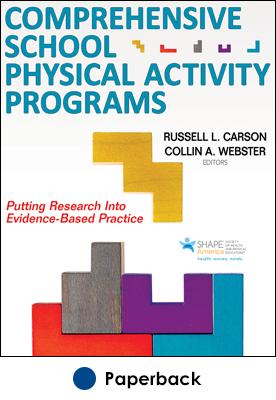Schools are the ideal place to promote and apply the recommended accumulation of 60 minutes of daily physical activity. But until now, it has been difficult to bridge the gap between research in this area and day-to-day practice in order to establish solid programs.
That’s where Comprehensive School Physical Activity Programs: Putting Research Into Evidence-Based Practice comes in.
Book Organization
The text is organized into six sections:
Part I provides the historical and foundational perspectives and policy landscapes of the CSPAP approach.
Part II outlines internal, external, and psychological factors to consider in program design, implementation, and sustainability.
In part III, the contributors examine and interpret the research on the effectiveness of established programs and previous interventions.
Part IV highlights special considerations for effective programming within urban and rural settings, reviews current and ongoing international CSPAP initiatives, and addresses the application of the model to alternative contexts beyond the K-12 school setting.
In part V, the contributors focus on using assessments to determine the physical activity promotion needs of a school community, on the instruments and procedures for measuring school-wide programming, and on the processes for evaluating and advocating for CSPAPs.
Part VI examines current reform efforts within preprofessional programs in teacher education, reviews the tools and future potential for using technology to deliver and assess CSPAP efforts, and looks at future directions for the disciplines of study that inform the CSPAP knowledge base.
Each chapter uses a format that opens with a review of current research, offers knowledge claims based on the research, notes knowledge gaps and directions for future research, offers evidence-based recommendations and applications, and concludes with questions to consider for discussion and case examples to demonstrate the practical recommendations.
That’s where Comprehensive School Physical Activity Programs: Putting Research Into Evidence-Based Practice comes in.
Book Organization
The text is organized into six sections:
Part I provides the historical and foundational perspectives and policy landscapes of the CSPAP approach.
Part II outlines internal, external, and psychological factors to consider in program design, implementation, and sustainability.
In part III, the contributors examine and interpret the research on the effectiveness of established programs and previous interventions.
Part IV highlights special considerations for effective programming within urban and rural settings, reviews current and ongoing international CSPAP initiatives, and addresses the application of the model to alternative contexts beyond the K-12 school setting.
In part V, the contributors focus on using assessments to determine the physical activity promotion needs of a school community, on the instruments and procedures for measuring school-wide programming, and on the processes for evaluating and advocating for CSPAPs.
Part VI examines current reform efforts within preprofessional programs in teacher education, reviews the tools and future potential for using technology to deliver and assess CSPAP efforts, and looks at future directions for the disciplines of study that inform the CSPAP knowledge base.
Each chapter uses a format that opens with a review of current research, offers knowledge claims based on the research, notes knowledge gaps and directions for future research, offers evidence-based recommendations and applications, and concludes with questions to consider for discussion and case examples to demonstrate the practical recommendations.





